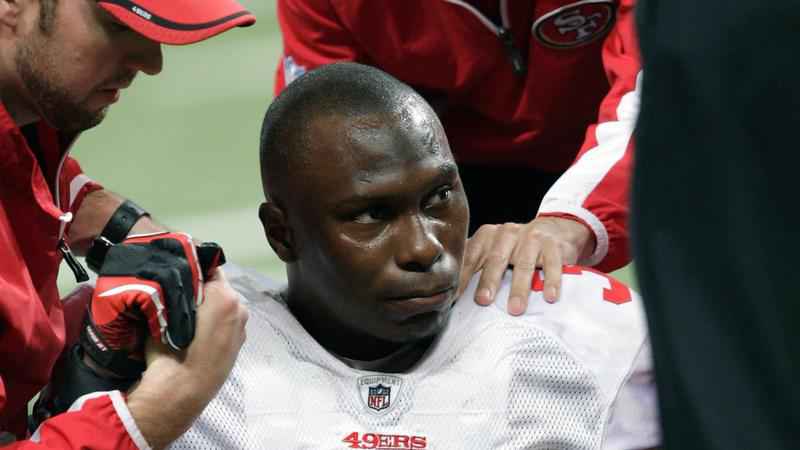Autopsy: Severe brain trauma in ex-NFL player who shot 6

FILE - In this Dec. 26, 2010, file photo, San Francisco 49ers cornerback Phillip Adams (35) is attended to after injuring his left leg during the third quarter of an NFL football game against the St. Louis Rams, in St. Louis. On Tuesday, Dec. 14, 2021, a coroner is set to release the results of a brain test for chronic traumatic encephalopathy on former NFL player Adams, who was accused of fatally shooting six people in Rock Hill, South Carolina, before killing himself in April. Adams' family agreed after his death to have his brain tested for the degenerative disease linked to head trauma and concussions.[AP Photo/Tom Gannam, File]
A coroner says an autopsy shows unusually severe brain disease in the frontal lobe of the former NFL player accused of fatally shooting six people in Rock Hill, South Carolina before killing himself in April.
The twenty years ex-football pro Phillip Adams spent playing football "definitely … gave rise" to a diagnosis of stage 2 chronic traumatic encephalopathy, said Dr. Ann McKee, who examined Adams’ brain.
Authorities have said that on April 7, Phillip Adams killed Rock Hill physician Robert Lesslie; his wife, Barbara; two of their grandchildren, 9-year-old Adah Lesslie and 5-year-old Noah Lesslie; and two HVAC technicians working at the Lesslie home, James Lewis and Robert Shook, both 38. Police later found Adams with a self-inflicted gunshot wound to the head.
The degenerative disease known as CTE is linked to head trauma and concussions that has been shown to cause a range of symptoms, including violent mood swings and memory loss.
McKee, who directs the CTE Center at Boston University, said of 24 NFL diagnosed with the disease after dying in their 20s and 30s, most had stage 2, like Adams. The disease has four stages, with stage 4 being the most severe and usually associated with dementia.
The second stage is associated with progressive cognitive and behavioral abnormalities such as aggression, impulsivity, explosivity, depression, paranoia, anxiety, poor executive function and memory loss, McKee said.
But Adams’ CTE diagnosis was different from the other young players because it was "unusually severe" in both of his frontal lobes, said the expert.
The Adams family said in a prepared statement that they were not surprised by the results, but were shocked to learn how severe his condition was.
"After going through medical records from his football career, we do know that he was desperately seeking help from the NFL but was denied all claims due to his inability to remember things and to handle seemingly simple tasks, such as traveling hours away to see doctors and going through extensive evaluations," their statement said.
CTE, which can only be diagnosed through an autopsy, has been found in former members of the military, football players, boxers and others who have been subjected to repeated head trauma. One recent study found signs of the debilitating disease in 110 of 111 NFL players whose brains were inspected.
Adams, 32, played in 78 NFL games for six teams over six seasons. He joined the San Francisco 49ers in 2010 as a seventh-round draft pick out of South Carolina State, and though he rarely started, he went on to play for New England, Seattle, Oakland and the New York Jets before finishing his career with the Atlanta Falcons in 2015.
As a rookie, Adams suffered a severe ankle injury and never played for the 49ers again. Later, with the Raiders, he had two concussions over three games in 2012. Because he didn’t retire by 2014, he wouldn’t have been eligible for testing as part of a broad settlement between the league and former players over long-lasting concussion-related injuries.
Adams’ sister told USA Today after the killings that her brother’s "mental health degraded fast and terribly bad" in recent years and that the family noticed "extremely concerning" signs of mental illness, including an escalating temper and personal hygiene neglect.